戦争の文化人類学 Anthropological studies of war and political violence
戦争の文化人類学 Anthropological studies of war and political violence
”To
understand the Marine Corps' philosophy of
warfighting, we first need an appreciation for the nature of war
itself—its moral, mental, and physical characteristics and demands. A
common view of war among Marines is a necessary
base for the development of a cohesive doctrine because our
approach to the conduct of war derives from our understanding of the
nature of war.” - MCDP-1
Warfighting, in PDF
「海
兵隊の戦争についての哲学を理解するためには、まず、戦争そのものの性質、つまり、道徳
的、精神的、物理的な特徴と要求について理解する必要がある。海兵
隊員の共通の戦争観は、結束力のあるドクトリンを開発するために必要な基盤であり、戦争遂行へのアプローチは、戦争の本質に対する理解から派生するものだ
からである」米国海兵隊「戦闘マニュアル(MCDP-1
Warfighting)」
●「戦争」研究の緊急性
第二次大戦後から世紀末までにおよそ200の戦争 があり、全体で4,500万人の人びとが犠牲者となっ た(国際赤十字・国際赤三日月社連合)
●な ぜ文化人類学的アプローチをとるのか?
ジャーナリズムや国際政治において、第三世界や開発途上諸国における、内戦や紛争に対して、「前近代 的」「文明以前」という偏見が、以前よりも高まり、一種の悲観主義が蔓延している。
●近代紛争の特徴
1)地域や歴史的特殊性
紛争に人びとを動員する手段、指導原理、価値基準などが、地域の慣習や文化を活用するかたちでお こなわれている。
2)地球的規模における共通点
国民国家アイデンティティ、正統性と統治性の権原をめぐる議論、民族問題、天然資源、環境問題、 人口学的原因、小火器に代表される武器の拡散。
●研究の具体的方法
1)コミュニティにおける文化動態の把握:
民族誌学的方法
2)国家および国際的な政治経済動態の把握:
政治学・国際関係論・歴史学的手法ならびに、関連する研究者との連携
● 伝統社会や未開社会における紛争/戦争
Christopher Robert Hallpike (born 1938) is an English-Canadian anthropologist and an Emeritus Professor of Anthropology at McMaster University, Ontario, Canada. He is known for his extensive study of the Konso of Ethiopia and Tauade of New Guinea. Hallpike has researched and published on a wide range of subjects, including Ethiopia and Papua New Guinea; stateless societies; tribal warfare; systems of seniority based on age; the symbolism of hair style; sociocultural evolution; cultural materialism; Piaget, developmental psychology and primitive thought; the evolution of morality; the relevance of Darwinism and sociobiology in anthropology (especially the weaknesses of adaptationism); and the history of science. His photographs of 1960s Ethiopia and Papua New Guinea have recently been added to the Pitt Rivers Museum online photographic collection. Hallpike is critical of "journalists, science writers, historians, linguists, biologists, and especially evolutionary psychologists" who write about primitive societies with ignorance or even ideologically driven falsifications espousing theories that are "nonsense".Thus, in his book Ship of Fools he evaluates critically the scientific merit – or the lack of it – of theories presented by Emma Byrne about swearing, Yuval Harari about human history, Rene Girard about mimetic causation of violence, William Arens about his denial of human cannibalism, and Noam Chomsky about universal grammar in language acquisition.
「クリストファー・ロバート・ホールパイク(1938年生
まれ)はイギリス系カナダ人の人類学者で、カナダ・オンタリオ州マクマスター大学人類学名誉教授。エチオピアのコンソ族とニューギニアのタウアデ族に関す
る広範な研究で知られる。エチオピアとパプアニューギニア、無国籍社会、部族間の戦争、年齢に基づく年功序列制度、髪型の象徴性、社会文化進化、文化唯物
論、ピアジェ、発達心理学と原始思想、道徳の進化、人類学におけるダーウィニズムと社会生物学の関連性(特に適応主義の弱点)、科学史など、幅広いテーマ
について研究・出版している。1960年代のエチオピアとパプアニューギニアの写真は、最近ピット・リバーズ博物館のオンライン写真コレクションに追加さ
れた。ホールパイクは「ジャーナリスト、科学ライター、歴史家、言語学者、生物学者、そして特に進化心理学者」が、原始社会について無知であったり、ある
いはイデオロギーに駆られて「ナンセンス」な理論を信奉するような捏造を書いていることに批判的である。
このように、彼は著書『愚か者の船』の中で、悪態をつくことについてのエマ・バーン、人類の歴史についてのユヴァル・ハラリ、暴力の模倣的因果関係につい
てのルネ・ジラール、人間のカニバリズムの否定についてのウィリアム・アーレンス、言語習得における普遍文法についてのノーム・チョムスキーが提示した理
論の科学的なメリット、あるいはその欠如を批判的に評価している。」
Andrew P. Vayda (December 7, 1931 – January 15, 2022) was a Hungarian-born American anthropologist and ecologist who was a Distinguished Professor Emeritus of Anthropology and Ecology at Rutgers University. Maori Warfare, the book based on Vayda’s Ph.D. dissertation, was first published in 1960. Now a classic, it has been regarded as the authoritative work on the subject of Maori warfare in its last stage of evolution before being greatly altered by European weapons and ways. As such, it continues to guide archaeological research in New Zealand and has been important also for anthropological and ecological studies of war.In the 1960s, Vayda extended his studies of intergroup fighting to societies in Borneo and New Guinea. His New Guinea findings have special value as products of field research carried out among groups contacted and pacified by outsiders only a few years earlier. The findings figure prominently in an important 1989 article, “Explaining Why Marings Fought.” In this, Vayda admitted to certain errors of reification and fallacies of functional explanation in some of his own earlier work and he showed how avoidable ambiguities in the meaning of questions about why people fight have led to long, unproductive, and acrimonious debates among scholars. This last theme was taken up again in a 1992 review article on the anthropology of war.Both articles are included in Vayda’s 2009 essay collection, Explaining Human Actions and Environmental Changes. The 1989 article is noteworthy also as an extended illustration of Vayda’s abiding interest in analyzing and explaining explanation itself and in engaging with the philosophical literature on explanation.
「アンドリュー・P・ヴァイダ(1931年12月7日
-
2022年1月15日)は、ハンガリー生まれのアメリカの人類学者、生態学者で、ラトガース大学の人類学・生態学の特別名誉教授であった。ヴァイダの博士
論文に基づく著書『Maori
Warfare』は1960年に出版された。現在では古典となり、ヨーロッパの武器や方法によって大きく変化する前の、進化の最終段階にあったマオリの戦
争に関する権威ある著作とみなされている。1960年代、ヴァイダは集団間戦闘の研究をボルネオとニューギニアの社会にまで広げた。彼のニューギニアでの
発見は、わずか数年前に部外者によって接触され、平定された集団のなかで実施された現地調査の成果として、特別な価値がある。この発見は、1989年の重
要な論文、"Explaining Why Marings
Fought"(マリング族がなぜ争ったかを説明する)の中で重要な位置を占めている。この論文でヴァイダは、彼自身の以前の研究にあった再定義の誤りや
機能的説明の誤りを認め、「なぜ人は戦うのか」という問いの意味における回避可能な曖昧さが、いかに学者たちの間で長く非生産的で険悪な論争を引き起こし
てきたかを示した。この最後のテーマは、戦争の人類学に関する1992年の総説で再び取り上げられた。両論文は、ヴァイダの2009年のエッセイ集『人間
の行動と環境の変化を説明する』に収録されている。1989年の論文は、説明そのものを分析し説明すること、そして説明に関する哲学的文献に関与すること
へのヴァイダの変わらぬ関心を示すものとしても注目に値する。」
クリストファー・ホールパイクやアンドリュー・ヴァイダと
いう人類学者たちが人類の戦争や紛争を説明する
時に「人はなぜ争いをするのか?」という命題の立て方は、それに対する正答を与えることができず堂々巡りするので、すなわち、そのような問いの立て方がま
ずいと主張した論法なのである。
● 戦争に関する理論、いわゆる軍事研究のフォーマルアプローチ
● 地政学
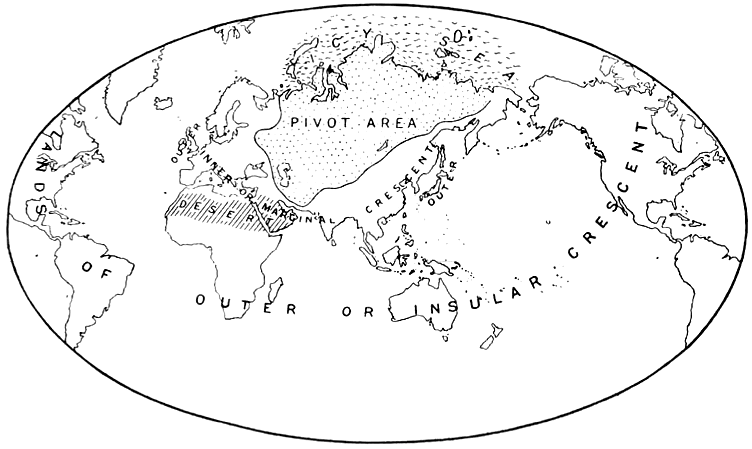
「Rudolf Kjellen (1864-1922)[チェーレンと読む]によって考案された用語で、政治地理学に対抗した動態的な権力政治論として構想された。国家を領土を維持・開 拓・進展させようする有機的形態(Lebensform)とみるところは、この時代の国家観を反映している」地政学)
マッキンダー(Sir Halford John Mackinder, 1861-1947)の地政学, "The Geographical Pivot of History, 1904": 「『東欧を支配する者はハートランド(heartland theory)を制し、ハートランドを支配する者は世界島を 制し、世界島を支配する者は世界を制する』。国際関係を動態力学的に把握するマッキンダー地政学の名著
According to Mackinder, the Earth's land
surface was divisible
into:
The World-Island, comprising the interlinked continents of Europe,
Asia, and Africa (Afro-Eurasia). This was the largest, most populous,
and richest of all possible land combinations.
The offshore islands, including the British Isles and the islands of
Japan.
The outlying islands, including the continents of North America, South
America, and Oceania.
The Heartland lay at the centre of the world island, stretching from
the Volga to the Yangtze and from the Himalayas to the Arctic.
Mackinder's Heartland was the area then ruled by the Russian Empire and
after that by the Soviet Union, minus the Kamchatka Peninsula region,
which is located in the easternmost part of Russia, near the Aleutian
Islands and Kurile islands.
第一章 われわれの前途によせて/ 第二章 社会の大勢/ 第三章 船乗りの世界像/ 第四章 内陸の人間の世界像/ 第五章 さまざまな帝国の興亡/ 第六章 諸国民の自由/ 第七章 人類一般の自由 /あとがき/ 補遺 一九一九年一月二五日、ケドルセーの一事件について /付録 (1)地理学からみた歴史の回転軸(一九〇四年) /(2) 球形の世界と平和の勝利(一九四三年)
On
Criticism: "K. S. Gadzhev, in his book Vvedenie v geopolitiku
(Introduction to Geopolitics) raises a series of objections to
Mackinder's Heartland; to start with that the significance physiography
is given there for political strategy is a form of geographical
determinism.[5]
Critics of the theory also argue that in modern day practice, the
theory is outdated due to the evolution of technological warfare, as at
the time of publication, Mackinder only considered land and sea powers.
In modern day time there are possibilities of attacking a rival without
the need for a direct invasion via cyber attacks, aircraft or even use
of long range missile strikes.
Other critics of the theory argue that "Mackinderian analysis is not
rational because it assumes conflict in a system where there is
none"[4]
Mackinder's theory was also never fully proven[6] as no singular power
in history has had control of all three of the regions at the same
time. The closest this ever occurred was during the Crimean
War(1853-1856) whereby Russia attempted to fight for control over the
Crimean Peninsula, ultimately losing to the French and the British."
●マハンの海戦論
マハン,アルフレッ
ド・セイヤー
(Alfred
Thayer Mahan)1840‐1914年。米国の海軍士官、海軍史家、海軍戦略家。最終階級は海軍少将。二度にわたって海軍大学校校長を
務め、海軍戦略を講義した。1890年、海軍大学校の講議録を元に『シー・パワーが歴史に及ぼした影響』(The Influence of Sea
Power upon
History)を出版し、海軍史家および海軍戦略家として世界的に名声を博す。同時代の国際関係や外交に関する著作も多く、政治家との交流や世論への働
きかけを通じて米国の外交・海軍政策に影響力を振るった。マッキンダーとともに地政学の祖としても知られる
●戦争の技術論(「大 艦巨砲主義」を事例に)
 HMS
Dreadnought (1906); Her Majesty's ship Dreadnought; "HMS Dreadnought
was a Royal Navy battleship whose design revolutionised naval power.
The ship's entry into service in 1906 represented such an advance in
naval technology that her name came to be associated with an entire
generation of battleships, the "dreadnoughts", as well as the class of
ships named after her. Likewise, the generation of ships she made
obsolete became known as "pre-dreadnoughts". Admiral Sir John "Jacky"
Fisher, First Sea Lord of the Board of Admiralty, is credited as the
father of Dreadnought. Shortly after he assumed office, he ordered
design studies for a battleship armed solely with 12 in (305 mm) guns
and a speed of 21 knots (39 km/h; 24 mph). He convened a "Committee on
Designs" to evaluate the alternative designs and to assist in the
detailed design work.
Dreadnought was the first battleship of her era to have a uniform main
battery, rather than having a few large guns complemented by a heavy
secondary armament of smaller guns. She was also the first capital ship
to be powered by steam turbines, making her the fastest battleship in
the world at the time of her completion.[1] Her launch helped spark a
naval arms race as navies around the world, particularly the Imperial
German Navy, rushed to match it in the build-up to the First World
War.[2]
Ironically for a vessel designed to engage enemy battleships, her only
significant action was the ramming and sinking of German submarine SM
U-29, becoming the only battleship confirmed to have sunk a
submarine.[3] Dreadnought did not participate in the Battle of Jutland
in 1916 as she was being refitted. Nor did Dreadnought participate in
any of the other First World War naval battles. In May 1916 she was
relegated to coastal defence duties in the English Channel, before
rejoining the Grand Fleet in 1918. The ship was reduced to reserve in
1919 and sold for scrap two years later."
HMS
Dreadnought (1906); Her Majesty's ship Dreadnought; "HMS Dreadnought
was a Royal Navy battleship whose design revolutionised naval power.
The ship's entry into service in 1906 represented such an advance in
naval technology that her name came to be associated with an entire
generation of battleships, the "dreadnoughts", as well as the class of
ships named after her. Likewise, the generation of ships she made
obsolete became known as "pre-dreadnoughts". Admiral Sir John "Jacky"
Fisher, First Sea Lord of the Board of Admiralty, is credited as the
father of Dreadnought. Shortly after he assumed office, he ordered
design studies for a battleship armed solely with 12 in (305 mm) guns
and a speed of 21 knots (39 km/h; 24 mph). He convened a "Committee on
Designs" to evaluate the alternative designs and to assist in the
detailed design work.
Dreadnought was the first battleship of her era to have a uniform main
battery, rather than having a few large guns complemented by a heavy
secondary armament of smaller guns. She was also the first capital ship
to be powered by steam turbines, making her the fastest battleship in
the world at the time of her completion.[1] Her launch helped spark a
naval arms race as navies around the world, particularly the Imperial
German Navy, rushed to match it in the build-up to the First World
War.[2]
Ironically for a vessel designed to engage enemy battleships, her only
significant action was the ramming and sinking of German submarine SM
U-29, becoming the only battleship confirmed to have sunk a
submarine.[3] Dreadnought did not participate in the Battle of Jutland
in 1916 as she was being refitted. Nor did Dreadnought participate in
any of the other First World War naval battles. In May 1916 she was
relegated to coastal defence duties in the English Channel, before
rejoining the Grand Fleet in 1918. The ship was reduced to reserve in
1919 and sold for scrap two years later."
「大艦巨砲主義」
「大艦巨砲主義(たいかんきょほうしゅぎ)とは、艦隊決戦による敵艦隊撃滅のため大口径の主 砲を搭載し重装甲の艦体を持つ戦艦を中心とする 艦隊を指向する海軍軍戦備・建艦政策および戦略思想[1]。巨砲大艦主義、巨艦巨砲主義、巨砲巨艦主義、大艦大砲主義とも言う。 英国海軍戦艦ドレッドノート (1906年)が各国間の建艦競争を大艦巨砲主義に走らせる契機となった[2]。しかし、タラント空襲や真珠湾攻撃、マレー沖海戦の戦訓により、適切な航 空援護なしに戦艦を戦闘に参加させてはならないことが認識された[3]。19世紀末ごろから主に蒸気機関の発達によって、大型で高速の艦艇が作れるように なった。 同時に艦砲は大型化するほど射程も伸び、威力も大きくなる。そこで、大型の軍艦に大型の砲をより多く搭載しようという考え方が大艦巨砲主義であり、19世 紀末から20世紀前半まで主要海軍国で支持されていた[4]。 日本海軍でも、日露戦争時の日本海海戦で大艦巨砲と「艦隊決戦」を至上とする考え方が確立された(海 戦要務令)。その後も太平洋戦争後半期まで軍令・戦術上の主流となった。長駆侵攻してくる敵艦隊を全力で迎撃・撃退するのが基本方針であり、その 際の主役は戦艦とされ、航空母艦・巡洋艦・駆逐艦などは脇役に過ぎないという思想があった。[要出典] 大艦巨砲主義の進展は、方位盤をはじめとする射撃管制装置の発達とも関連し ている。射程の長い砲があっても、遠距離で敵艦に命中させられる技術がなければ無意味だからである。 「ドレッドノート」が画期的だったのは、多数の主砲の射撃管制を可能とする射法の完成あってのことである。1940年頃まで各国の戦艦は光学式測距儀と方 位盤射撃を用いた射撃管制装置を主用していた。しかし米英では1941年以降レーダーの実用化により、着弾観測については光学式測距儀よりもレーダーを使 用した電測射撃に移行していった。これに対し、日独は米英に電子兵装で格段に後れを取り、電測測距と併用したものの、光学式測距儀を最後まで実戦で主用し た。なお、フランスはすぐに敗戦したため、射撃用レーダーを搭載したもののその効果は不明である。イタリアは終戦時まで対空見張り用レーダーのみだった。 光学式の測距はとくに遠距離射撃では誤差が大きく、近距離でも夜間、曇天、悪天候などで視界の悪い時にレーダー管制に劣っていた。そのため、水上艦艇同士 の戦闘において電測射撃が行えることはかなり優位だった。ただ、初期の射撃用レーダーは測距性能は充実していたものの方位探知角が不足しており、時には光 学観測射撃に後れを取ることもあった。[要出典]。
| 米
国と英国 |
日
本とドイツ |
フ
ランス |
イタリア |
| 1940年頃まで各国の戦艦は光学式測距儀と方位盤射撃を用いた射撃管
制装置を主用していた。光学式の測距はとくに遠距離射撃では誤差が大きく、近距離でも夜間、曇天、悪天候などで視界の悪い時にレーダー管制に劣っていた。
そのため、水上艦艇同士の戦闘において電測射撃が行えることはかなり優位だった。ただ、初期の射撃用レーダーは測距性能は充実していたものの方位探知角が
不足しており、時には光学観測射撃に後れを取ることもあった。 ●米英では1941年以降レーダーの実用化により、着弾観測については光学式測距儀よりもレーダーを使用した電測射撃に移行していった。 |
1940年頃まで各国の戦艦は光学式測距儀と方位盤射撃を用いた射撃管
制装置を主用していた。光学式の測距はとくに遠距離射撃では誤差が大きく、近距離でも夜間、曇天、悪天候などで視界の悪い時にレーダー管制に劣っていた。
そのため、水上艦艇同士の戦闘において電測射撃が行えることはかなり優位だった。ただ、初期の射撃用レーダーは測距性能は充実していたものの方位探知角が
不足しており、時には光学観測射撃に後れを取ることもあった。 ●日独は米英に電子兵装で格段に後れを取り、電測測距と併用したものの、光学式測距儀を最後まで実戦で主用した |
1940年頃まで各国の戦艦は光学式測距儀と方位盤射撃を用いた射撃管
制装置を主用していた。光学式の測距はとくに遠距離射撃では誤差が大きく、近距離でも夜間、曇天、悪天候などで視界の悪い時にレーダー管制に劣っていた。
そのため、水上艦艇同士の戦闘において電測射撃が行えることはかなり優位だった。ただ、初期の射撃用レーダーは測距性能は充実していたものの方位探知角が
不足しており、時には光学観測射撃に後れを取ることもあった。 ●フランスはすぐに敗戦したため、射撃用レーダーを搭載したもののその効果は不明である。 |
1940年頃まで各国の戦艦は光学式測距儀と方位盤射撃を用いた射撃管
制装置を主用していた。光学式の測距はとくに遠距離射撃では誤差が大きく、近距離でも夜間、曇天、悪天候などで視界の悪い時にレーダー管制に劣っていた。
そのため、水上艦艇同士の戦闘において電測射撃が行えることはかなり優位だった。ただ、初期の射撃用レーダーは測距性能は充実していたものの方位探知角が
不足しており、時には光学観測射撃に後れを取ることもあった。 ●イタリアは終戦時まで対空見張り用レーダーのみだった。 |
他国より大型の戦艦に巨大な主砲を搭載するという、文字どおりの大艦巨砲主義は1936年の
ワシントン海軍軍縮条約明け後には終焉を迎え、
前代と同程度、あるいはやや小型化した主砲の採用例が多くなった。
第一次世界大戦中の1916年に生起したユトランド沖海戦において、イギリスとドイツが弩級戦艦・超弩級戦艦を含む艦隊で衝突し、長距離砲撃戦の重要性が
再認識されたことで各国の大艦巨砲主義は一層強まり[5]、速力と防御力の向上を追求したポスト・ジュットランド艦(高速戦艦)が建造されたが、必然的に
排水量も増えてしまい主砲口径の増大を諦めざるを得なかった為である。
この反省から、速力・防御力のバランスが戦艦の設計で重要視されるようになった。これまでの戦艦は速度を、巡洋戦艦は防御力を妥協して排水量を抑えていた
が、そのような設計の問題点が明らかになった。
そして、航空機の発達により第二次世界大戦中に航空機の優位が確立、航空主兵論の台頭が戦艦時代の終わりを告げることとなった。
アメリカで計画されていた、大和型戦艦(72,800t 45口径46cm 9門)と同等のモンタナ級戦艦(71,922t 50口径16インチ砲
12門)全5隻が1943年に建造中止されたことをもって戦艦は終焉を迎えた。
その後竣工したアイオワ級戦艦やヴァンガードやジャン・バールなどはそれ以前に起工したものであり、以後戦艦の新造は行われていない」大艦巨砲主義)。
●総力戦
「総力戦とは、純粋に合法的な軍事目標に限定されない戦争であり、大量の民間人や非戦闘員の
苦痛や死傷者を出す可能性がある。この場合の、総力
戦(total war)は、エーリッヒ・ルーデンドルフ(Erich Ludendorff,
1865-1937)の主著のタイトルである『総力戦(Der totale Krieg,
1934)』から生まれたことばで、一般的(ウィキペディア)には「全面戦争(total
wa)とは、あらゆる民間の関連資源やインフラを正当な軍事目標とし、社会のあらゆる資源を戦争に動員し、非戦闘員のニーズよりも戦争を優先させる戦争で
ある」と定義されている」戦争)
●戦争経済(war economy or wartime economy)ならびに戦時共産主義(War communism or military communism)
An American poster from World War I
explaining sugar rations. Sugar was being conserved to provide for
allied countries in Europe and support the war effort.
-第一次世界大戦中のアメリカのポスター。砂糖の配給について説明している。砂糖はヨーロッパの同盟国への供給と戦争遂行のために節約されていた
| A war economy or
wartime economy
is the set of contingencies undertaken by a modern state to mobilize
its economy for war production. Philippe Le Billon describes a war
economy as a "system of producing, mobilizing and allocating resources
to sustain the violence." Some measures taken include the increasing of
interest rates as well as the introduction of resource allocation
programs. Approaches to the reconfiguration of the economy differ from
country to country.[1] Many states increase the degree of planning in their economies during wars; in many cases this extends to rationing, and in some cases to conscription for civil defenses, such as the Women's Land Army and Bevin Boys in the United Kingdom during World War II. During total war situations, certain buildings and positions are often seen as important targets by combatants. The Union blockade, Union General William Tecumseh Sherman's March to the Sea during the American Civil War, and the strategic bombing of enemy cities and factories during World War II are all examples of total war.[2] Concerning the side of aggregate demand, the concept of a war economy has been linked to the concept of "military Keynesianism", in which the government's military budget stabilizes business cycles and fluctuations and/or is used to fight recessions. On the supply side, it has been observed[by whom?] that wars sometimes have the effect of accelerating technological progress to such an extent that an economy is greatly strengthened after the war, especially if it has avoided the war-related destruction. This was the case, for example, with the United States in World War I and World War II. Some economists (such as Seymour Melman) argue, however, that the wasteful nature of much of military spending eventually can hurt technological progress. War is often used as a last ditch effort to prevent deteriorating economic conditions or currency crises, particularly by expanding services and employment in the military, and by simultaneously depopulating segments of the population to free up resources and restore the economic and social order. A temporary war economy can also be seen as a means to avoid the need for more permanent militarization. During World War II, U.S. President Franklin D. Roosevelt stated that if the Axis powers won, then "we would have to convert ourselves permanently into a militaristic power on the basis of war economy."[3] |
戦時経済とは、戦争の生産のために経済を動員するために近代国家が講じ
る一連の対策のことである。フィリップ・ル・ビヨンは、戦時経済を「暴力を維持するために資源を生産、動員、配分するシステム」と表現している。講じられ
た対策には、金利の上昇や資源配分プログラムの導入などがある。経済の再構成へのアプローチは国によって異なる[1]。 多くの国家は戦争中に経済計画を強化し、多くの場合、配給制に拡大し、場合によっては第二次世界大戦中の英国における女子挺身隊やベビン・ボーイズのよう な民間防衛のための徴兵制にまで拡大した。 全面戦争の状況では、特定の建物や位置は戦闘員にとって重要な目標と見なされることが多い。南北戦争における北軍による連合国封鎖、ウィリアム・テカム セ・シャーマンの「海への進軍」、第二次世界大戦における敵国都市や工場への戦略爆撃などは、総力戦の例である[2]。 総需要の側面に関して、戦争経済という概念は、「軍事ケインズ主義」という概念と結びつけられてきた。これは、政府の軍事予算が景気循環や変動を安定化さ せ、あるいは不況対策として用いられるというものである。供給面においては、戦争が時に技術進歩を加速させる効果があり、戦争による破壊を免れた場合、戦 争後に経済が大幅に強化されることがあることが観察されている[by whom?]。これは、例えば第一次世界大戦と第二次世界大戦におけるアメリカ合衆国の場合がそうであった。しかし、一部の経済学者(Seymour Melmanなど)は、軍事支出の多くが無駄遣いであるために、結局は技術進歩を妨げる可能性があるとしている。 戦争は、経済状況の悪化や通貨危機を防ぐための最後の手段としてよく用いられる。特に、軍におけるサービスや雇用を拡大し、同時に人口の一部を減少させて 資源を確保し、経済・社会秩序を回復させることによってである。一時的な戦争経済は、より恒久的な軍国主義化を回避するための手段とも見なされる。第二次 世界大戦中、フランクリン・D・ルーズベルト米大統領は、枢軸国が勝利した場合、「私たちは戦争経済を基盤に恒久的に軍国主義国家へと転換せざるを得ない だろう」と述べた[3]。 |
| United States The United States has a very complex history with wartime economies. Many notable instances came during the twentieth century in which America's main conflicts consisted of the World Wars, the Korean War, and the Vietnam War. World War I 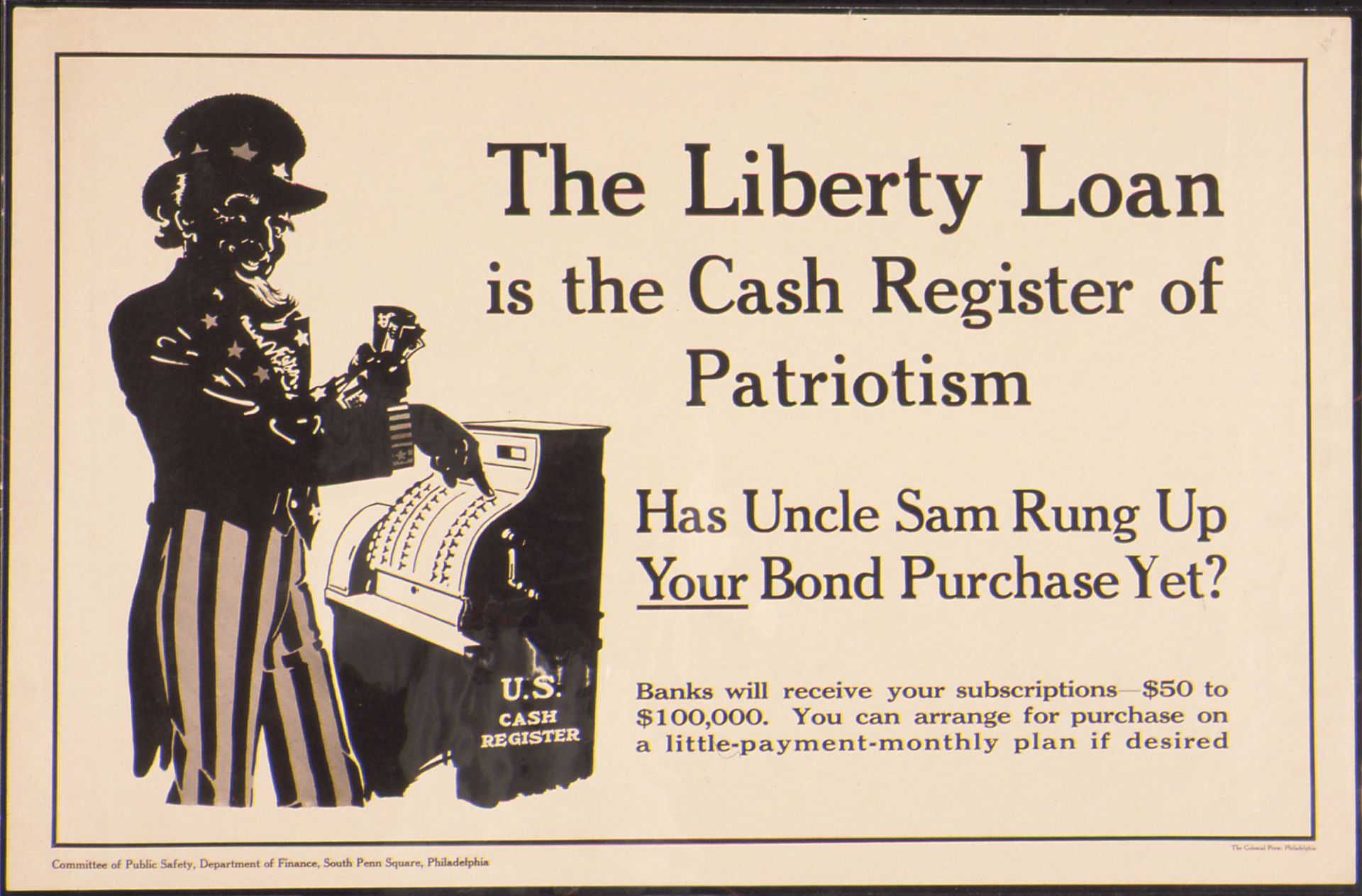 Poster issued during the First World War by the educational division of the U.S. Food Administration In mobilizing for World War I, the United States expanded its governmental powers by creating institutions such as the War Industries Board (WIB) to help with military production.[4] Others, such as the Fuel Administration, introduced daylight saving time in an effort to save coal and oil while the Food Administration encouraged higher grain production and "mobilized a spirit of self-sacrifice rather than mandatory rationing."[4] Propaganda also played a large part in garnering support for topics ranging from tax initiatives to food conservation. Speaking on Four Minute Men, volunteers who rallied the public through short speeches, investigative journalist George Creel stated that the idea was extremely popular and the program saw thousands of volunteers throughout the states.[5] World War II 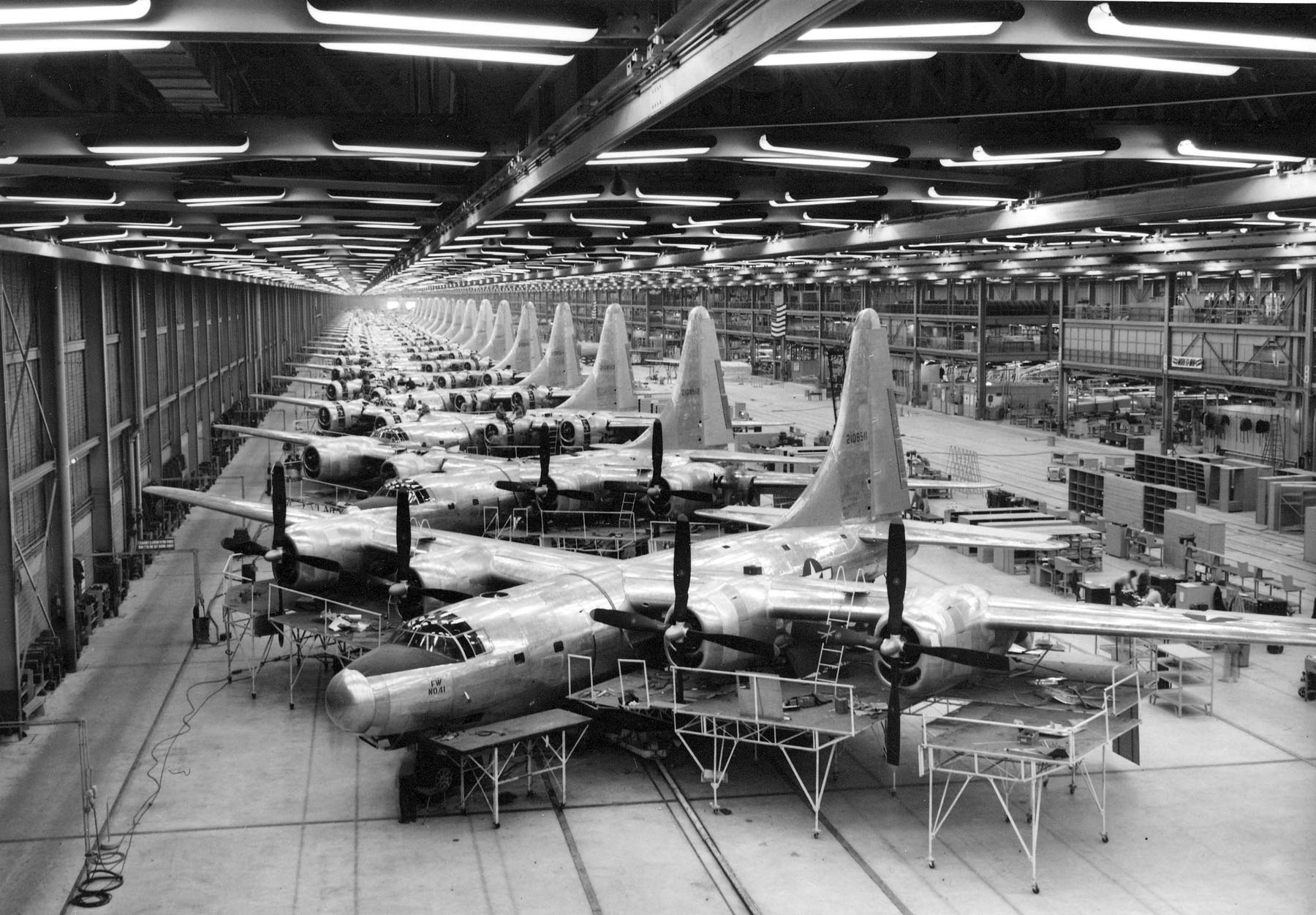 Mass production of Consolidated B-32 Dominator airplanes at Consolidated Aircraft Plant No. 4, near Fort Worth, Texas, during World War II. In the case of the Second World War, the U.S. government took similar measures in increasing its control over the economy. The Fall of France and the shifting of the front line into the English Channel with the outcome of the looming Battle of Britain uncertain provided the spark needed to begin conversion to a wartime economy with the passing of the Two-Ocean Navy Act in July 1940. The subsequent Attack on Pearl Harbor prolonged and expanded the measures. Washington felt that a greater bureaucracy was needed to help with mobilization.[6] The government raised taxes which paid for half of the war's costs and borrowed money in the form of war bonds to cover the rest of the bill.[4] "Commercial institutions like banks also bought billions of dollars of bonds and other treasury paper, holding more than $24 billion at the war's end."[6] The creation of a handful of agencies helped funnel resources towards the war effort. One prominent agency was the War Production Board (WPB), which "awarded defense contracts, allocated scarce resources – such as rubber, copper, and oil – for military uses, and persuaded businesses to convert to military production."[4] The United States mass-produced many vehicles, such as ships (i.e. Liberty Ships), aircraft (i.e. North American P-51 Mustang), jeeps (i.e. Willys MB) and tanks (i.e. M4 Sherman). Two-thirds of the American economy had been integrated into the war effort by the end of 1943.[4] Because of this massive cooperation between government and private entities, it could be argued that the economic measures enacted prior to and during the Second World War helped lead the Allies to victory. Present day The United States has been involved in numerous military endeavours within the Middle East and Latin America since the 1960s. Having been in a continuous state of war since the September 11 attacks,[7] they have an annual military budget larger than India, China, Russia, United Kingdom, Germany, Saudi Arabia, and France’s military budgets combined. |
アメリカ合衆国 アメリカ合衆国は、戦時経済と非常に複雑な歴史を持っている。20世紀には、アメリカが主な争いとして経験した戦争には、世界大戦、朝鮮戦争、ベトナム戦 争など、多くの著名な例がある。 第一次世界大戦  米国食糧管理局教育部門が第一次世界大戦中に発行したポスター 第一次世界大戦への参戦にあたり、米国は軍需生産を支援する機関として戦争産業委員会(WIB)を設立するなど、政府権限を拡大した[4]。燃料管理局 は、石炭と石油を節約するために夏時間を導入し、食糧管理局は穀物の増産を奨励し、「強制的な配給よりも自己犠牲の精神を動員した」[4]。また、税に関 する取り組みから食糧保存まで、さまざまなテーマに対する支持を集める上で、プロパガンダも大きな役割を果たした。「4分間の男たち」について、短いス ピーチで国民を鼓舞するボランティアについて、調査報道記者ジョージ・クリールは、このアイデアは非常に人気があり、このプログラムには全米で何千人もの ボランティアが参加したと述べた[5]。 第二次世界大戦  第二次世界大戦中、テキサス州フォートワース近郊のコンソリデーテッド・エアクラフト・プラント第4工場で、 Consolidated B-32 Dominator 航空機の大量生産が行われた。 第二次世界大戦の場合、米国政府は経済に対する統制を強化するために同様の措置を講じた。迫り来る「イギリス海峡の戦い」の行方が不確かな中、フランスが 陥落し、戦線がイギリス海峡へと移動したことは、1940年7月に「二大洋海軍法」が成立し、戦時経済への転換を始めるきっかけとなった。その後、真珠湾 攻撃により、その措置は長期化し、拡大した。ワシントンは、動員を支援するためにより大きな官僚機構が必要だと感じていた[6]。政府は、戦争費用の半分 を賄うために増税を行い、残りの費用をまかなうために戦時国債という形で資金を借り入れた[4]。「銀行などの商業機関も数十億ドルの国債や財務省証券を 購入し、戦争終結時には240億ドル以上を保有していた」[6]。少数の機関が創設されたことで、戦争努力に資源を集中させることが可能になった。著名な 機関のひとつに、戦争生産委員会(WPB)があった。これは「防衛契約を発注し、ゴム、銅、石油などの希少な資源を軍事用途に割り当て、企業が軍事生産に 転換するよう説得した」[4]。 米国は 船(リバティシップ)、航空機(ノースアメリカン P-51 ムスタング)、ジープ(ウィリス MB)、戦車(M4 シャーマン)など、多くの乗り物を大量生産した。 1943年末までに、アメリカ経済の3分の2が戦争遂行に組み込まれていた[4]。政府と民間企業の間のこの大規模な協力関係により、第二次世界大戦前と 戦中に実施された経済政策が連合国の勝利につながったという主張も成り立つ。 現在 アメリカは1960年代以降、中東と中南米で数多くの軍事活動に関与してきた。9月11日の同時多発テロ以来、戦争状態が続いており[7]、年間の軍事予 算はインド、中国、ロシア、イギリス、ドイツ、サウジアラビア、フランスの軍事予算を合わせた額を上回る。 |
| Germany World War I Germany has experienced economic devastation following both World Wars. While this was not a result of faulty economic planning, it is important to understand the ways that Germany approached reconstruction. In World War I, the German agricultural sector was hit hard by the demands of the war effort. Not only were many of the workers conscripted, but much of the food itself was allocated for the troops leading to a shortage.[8] "German authorities were not able to solve the food scarcity [problem], but implemented a food rationing system and several price ceilings to prevent speculation and profiteering. Unfortunately, these measures did not have the desired success."[8] World War II See also: Economy of Nazi Germany § Wartime policies: 1939–1945 Heading into the Second World War, the Nazis introduced new policies that not only caused the unemployment rate to drop, it created a competent war machine in clear violation of the Treaty of Versailles. The Third Reich implemented a draft and built factories to supply its quickly expanding military. Both of these actions created jobs for many Germans who had been struggling from the economic collapse following World War I.[9] However, it is worth noting that while unemployment rates plummeted, "by 1939, government debt stood at over 40 billion Reichsmarks (equivalent to 178 billion 2021 euros)."[9] During the war, Germany heavily exploited the economies of countries it conquered. The most important among these, according to historians Boldorf and Scherner, was France and "her highly developed economy... [being] one of the biggest in Europe."[10] This is further supported when they later reveal how the French economy provided for 11 percent of Germany's national income (during the occupation) which covered five months of Germany's total income for the war. Using extortion and forced labor, the Nazis siphoned off much of France's economic output. For example, during the early months of the Nazi occupation, the French puppet government was forced to pay a "quartering" fee of twenty million Reichsmarks per day. Supposedly, the fee was payment for the Nazi occupation forces. In reality, the money was used to fuel the Nazi war economy.[10] Germany employed numerous methods to support its war effort. However, due to the Nazis' surrender to the Allies, it is hard to tell what their economic policies would have yielded in the long term. |
ドイツ 第一次世界大戦 ドイツは、2度の世界大戦を経て経済的に壊滅的な打撃を被った。これは経済計画の失敗によるものではないが、ドイツの復興への取り組みを理解することは重 要である。第一次世界大戦では、ドイツの農業部門は戦争遂行の要求により大きな打撃を受けた。多くの労働者が徴兵されただけでなく、食糧の多くが軍に割り 当てられ、不足につながった[8]。 「ドイツ当局は食糧不足の問題を解決することはできなかったが、投機や暴利を防ぐために食糧配給制度と複数の価格上限を導入した。 残念ながら、これらの措置は期待通りの成果を上げることができなかった」[8]。 第二次世界大戦 関連項目:ナチス・ドイツの経済 § 戦時政策: 1939年~1945年 第二次世界大戦に突入するにあたり、ナチスは失業率を低下させるだけでなく、ベルサイユ条約に明確に違反する強力な戦争機械を作り出す新たな政策を導入し た。第三帝国は徴兵制を実施し、急速に拡大する軍隊に供給するための工場を建設した。これらの政策により、第一次世界大戦後の経済破綻で苦しんでいた多く のドイツ人に職が与えられた[9]。しかし、失業率が急落する一方で、「1939年までに、政府の負債は400億ライヒスマルク(2021年のユーロに換 算すると1780億ユーロ)以上」に達していた[9]ことは注目に値する。戦争中、ドイツは征服した国の経済を徹底的に搾取した。歴史家のボルドルフと シェナーによると、その中でも最も重要なのはフランスであり、「その高度に発達した経済は...ヨーロッパでも最大級であった」[10]。これは、彼らが 後に明らかにした、フランスの経済がドイツの国民所得の11%を供給していた事実(占領中)によってさらに裏付けられる。ナチスは、強要や強制労働によっ てフランスの経済生産の多くを吸い上げた。例えば、ナチス占領の初期の数か月間、フランスの傀儡政府は1日あたり2,000万ライヒスマルクの「宿営」料 を支払うことを余儀なくされた。この料金は、ナチス占領軍への支払い金だったとされている。しかし実際には、このお金はナチスの戦争経済を後押しするため に使われた[10]。ドイツは戦争遂行のためにさまざまな手段を用いた。しかし、ナチスが連合国に降伏したため、彼らの経済政策が長期的にどのような結果 をもたらしたかは、はっきりしない。 |
| Other examples Armenia is another example that followed war economy principles, especially during the 2020 Nagorno-Karabakh war. Armenia is a small country in a blockade in the Caucasus region but still increased its military budget after 2018 reaching $640 million. In 2019 it was 18.8% of the total Armenian budget.[11] Except mobilizing financial resources, Armenia also declared mobilization and concentrated human capital (volunteers, doctors, soldiers).[12] |
その他の例 アルメニアも、特に2020年のナゴルノ・カラバフ戦争中に、戦争経済原則に従った例である。アルメニアはコーカサス地方にある封鎖された小国だが、 2018年以降も軍事予算を増やし、6億4000万ドルに達した。2019年には、アルメニアの予算総額の18.8%を占めた[11]。アルメニアは、資 金源を動員するだけでなく、人的資本(ボランティア、医師、兵士)の動員も宣言した[12]。 |
| Companies by arms sales Defense Economics Diversionary war Economic nationalism Economic warfare Industrial warfare Military–industrial complex Mass production Permanent war economy Resistance economy Total war War communism War effort Wartime propaganda |
武器販売による企業 防衛経済 陽動作戦 経済ナショナリズム 経済戦争 産業戦争 軍産複合体 大量生産 恒久戦争経済 抵抗経済 全面戦争 戦争共産主義 戦争努力 戦時宣伝 |
| https://en.wikipedia.org/wiki/War_economy |
|
| War communism or
military communism
(Russian: Военный коммунизм, Vojenný kommunizm) was the economic and
political system that existed in Soviet Russia during the Russian Civil
War from 1918 to 1921. War communism began in June 1918, enforced by
the Supreme Economic Council (Russian: Высший Совет Народного
Хозяйства), known as the Vesenkha. It ended on 21 March 1921, with the
beginning of the New Economic Policy, which lasted until 1928. The
system has often been described as simple authoritarian control by the
ruling and military castes to maintain power and control in the Soviet
regions, rather than any coherent political ideology.[1] The Soviet
propaganda justified it by claiming that the Bolsheviks adopted this
policy with the goal of keeping towns (the proletarian power-base) and
the Red Army stocked with food and weapons since circumstances dictated
new economic measures. The deadly Russian famine of 1921–22, which killed about five million people, was in part triggered by Vladimir Lenin's war communism policies, especially food requisitioning.[2][3] However, the famine was preceded by bad harvests, harsh winter, drought especially in the Volga Valley which was exacerbated by a range of factors including the war, the presence of the White Army and the methods of war communism.[4] The outbreaks of diseases such as cholera and typhus were also contributing factors to the famine casualties.[5][6] |
戦争共産主義または軍事共産主義(ロシア語:Военный
коммунизм、Vojenný
kommunizm)とは、1918年から1921年にかけてのロシア内戦中にソビエトロシアで存在した経済・政治体制である。戦争共産主義は、1918
年6月に最高経済会議(ロシア語:Высший Совет Народного
Хозяйства)によって施行された。1921年3月21日、新経済政策の開始とともに終了した。新経済政策は1928年まで続いた。この体制は、一
貫した政治イデオロギーというよりも、ソビエト地域における権力と支配を維持するために支配階級と軍人階級が採用した単純な権威主義的統制であるとよく説
明されてきた[1]。ソビエトのプロパガンダは、ボリシェヴィキがこの政策を採用したのは、状況によって新たな経済政策が必要となったためであり、都市
(プロレタリアートの勢力基盤)と赤軍に食料と武器を供給し続けることを目的としていたと主張することで、それを正当化した。 1921年から1922年にかけてロシアで発生した大飢饉では、約500万人が命を落としたが、その一因はウラジーミル・レーニンの戦時共産主義政策、特 に食糧徴発にあったとされる[2][3]。しかし、この大飢饉は不作、厳しい冬、干ばつ 特にヴォルガ川流域では、戦争、白軍の存在、戦争共産主義の方法など、さまざまな要因によって被害が拡大した[4]。コレラやチフスなどの病気の発生も、 飢饉による犠牲者の増加の一因となった[5][6]。 |
Policies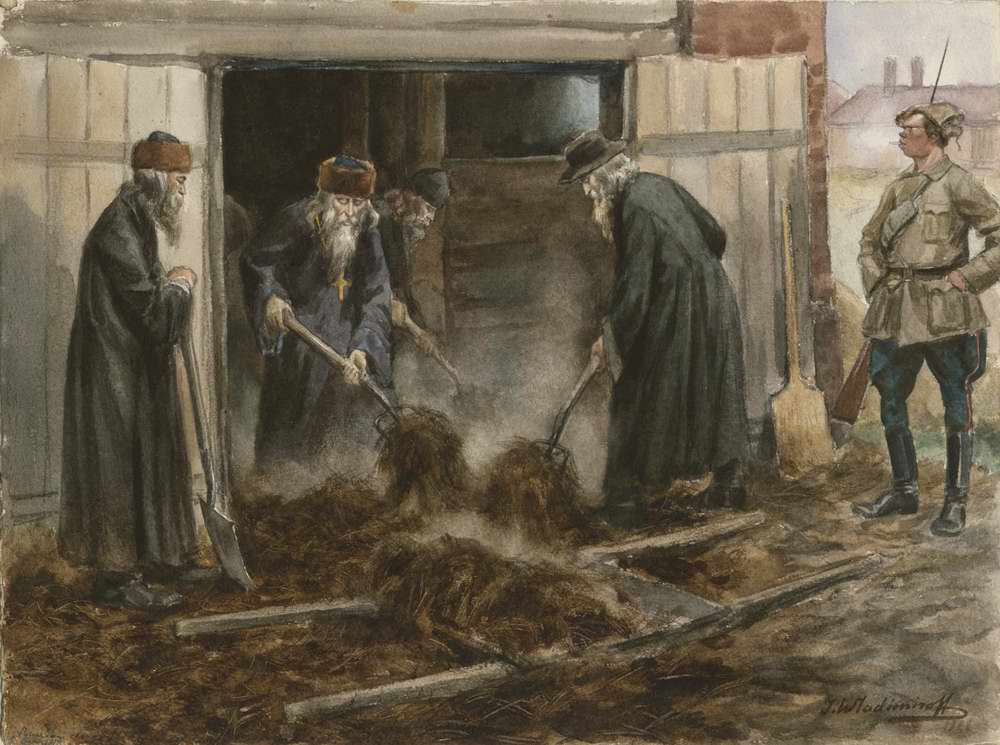 Clergy on Forced Labor by Ivan Vladimirov War communism included the following policies: Nationalization of all industries and the introduction of strict centralized management[citation needed] State control of foreign trade Strict discipline for workers, with strikes forbidden Obligatory labor duty by non-working classes Prodrazvyorstka – requisition of agricultural surplus (in excess of an absolute minimum) from peasants for centralized distribution among the remaining population Rationing of food and most commodities, with centralized distribution in urban centers Private enterprise banned Military-style control of the railways It has long been debated whether "war communism" represented an actual economic policy in the proper sense of the phrase, or merely a set of measures intended to win the civil war.[7] |
政策 強制労働に従事する聖職者たち』 イヴァン・ウラジーミロフ著 戦争共産主義には、以下のような政策が含まれていた。 すべての産業の国有化と厳格な中央集権的管理の導入[出典が必要] 外国貿易の国家管理 ストライキを禁じた労働者に対する厳格な規律 非労働者階級に対する義務労働 Prodrazvyorstka(プロドラズヴィョルストカ) - 農民から(絶対必要量を超える)農業余剰分を徴発し、 食料やほとんどの商品の配給制、都市部での集中配給 民間企業の禁止 鉄道の軍事的統制 「戦争共産主義」が、言葉の本来の意味における実際の経済政策を表していたのか、それとも内戦に勝利するための一連の政策に過ぎなかったのかについては、 長い間議論されてきた[7]。 |
| Background and aims See also: Prodrazverstka Historians have noted that both Tsarist Russia government councils and other opposition parties had advocated for food requisitioning prior to the ascent of the Bolsheviks.[8][9][10] However, the goals of the Bolsheviks in implementing war communism are a matter of controversy. Some commentators, including a number of Bolsheviks, have argued that its sole purpose was to win the war. Vladimir Lenin, for instance, said that "the confiscation of surpluses from the peasants was a measure with which we were saddled by the imperative conditions of war-time."[11] Other Bolsheviks, such as Yurii Larin, Lev Kritzman, Leonid Krasin, and Nikolai Bukharin, argued that it was a transitional step towards socialism.[12] Commentators, such as the historian Richard Pipes, the philosopher Michael Polanyi,[13] and economists, such as Paul Craig Roberts[14] or Sheldon L. Richman,[15] have argued that war communism was actually an attempt to immediately eliminate private property, commodity production and market exchange, and in that way to implement communist economics, and that the Bolshevik leaders expected an immediate and large-scale increase in economic output. This view was also held by Bukharin, who said that "We conceived War Communism as the universal, so to say 'normal' form of the economic policy of the victorious proletariat and not as being related to the war, that is, conforming to a definite state of the civil war".[16] |
背景と目的 参照: プロドラズヴェストカ 歴史家によると、ボリシェヴィキが台頭する以前、帝政ロシア政府機関と他の野党の両方が食糧徴発を主張していた[8][9][10]。しかし、戦争共産主 義を実施したボリシェヴィキの目標については議論の余地がある。ボリシェヴィキを含む一部の評論家は、その唯一の目的は戦争に勝つことだったと主張してい る。例えばウラジーミル・レーニンは、「農民からの余剰品の没収は、戦時下の緊急事態によって我々が負わされた措置であった」と述べた[11]。ユリー・ ラリン、レフ・クリツマン、レオニード・クラシン、ニコライ・ブハーリンなどの他のボリシェヴィキは、それは社会主義への過渡的な措置であると主張した [12]。歴史家のリチャード・パイプス、哲学者のマイケル・ポランニー[13]、経済学者ポール・クレイグ・ロバーツ[14]やシェルドン・L・リッチ マン[15]などの論客は、戦争共産主義は実際には私有財産、商品生産、市場交換を即座に排除し、共産主義経済を導入しようとする試みであり、ボリシェ ヴィキ指導部は即時かつ大規模な経済生産高の増加を期待していたと主張している。この見解はブハーリンも支持しており、彼は「我々は戦争共産主義を、勝利 したプロレタリアートの経済政策の普遍的、いわば『正常な』形態として構想した。戦争、つまり内戦の特定の状況に適合するものとしてではなく」[16]と 語っている。 |
| Results Military War communism was largely successful at its primary purpose of aiding the Red Army in halting the advance of the White Army, and in helping the Bolsheviks to re-conquer most of the territory of the former Russian Empire. Social 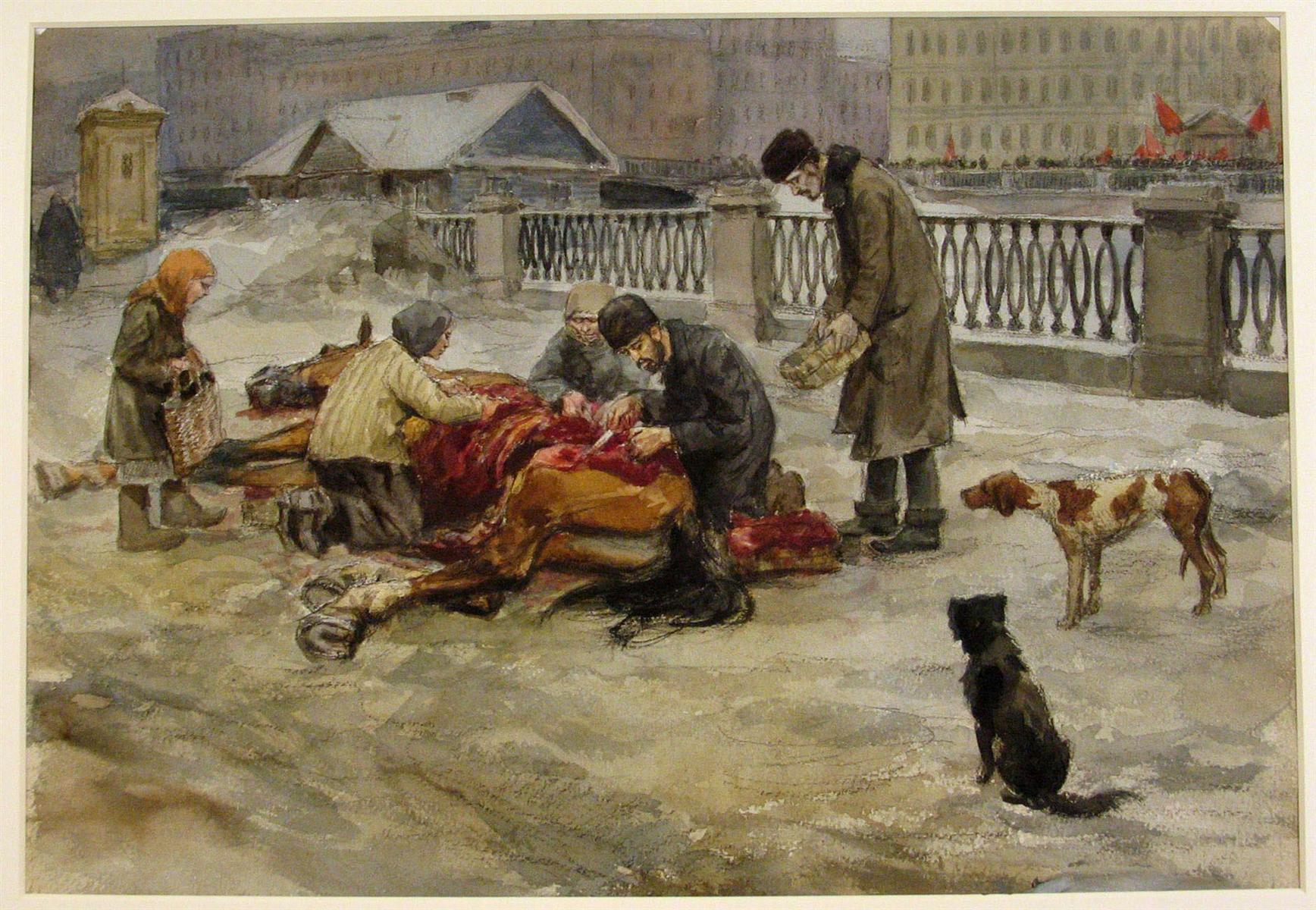 Famine by Ivan Vladimirov In the cities and surrounding countryside, the population experienced hardships as a result of the war. Peasants, because of the extreme scarcity, were beginning to refuse to co-operate in giving food for the war effort. Workers began migrating from the cities to the countryside, where the chances to feed themselves were higher, thus further decreasing the possibility of barter of industrial goods for food and worsening the plight of the remaining urban population and further weakening the economy and industrial production. Between 1918 and 1920, Petrograd lost 70% of its population, while Moscow lost over 50%.[17] Barrier troops were also used to enforce Bolshevik control over food supplies in areas controlled by the Red Army to protect against raids from anti-communist forces.[18] A series of workers' strikes and peasants' rebellions against war communism policies broke out all over the country, such as the Tambov Rebellion (1920–1921), which was neutralized by the Red Army. A turning point came with the Kronstadt rebellion at the Kronstadt naval base in early March 1921, which also ended with a Bolshevik victory. The rebellion startled Lenin because Bolsheviks considered Kronstadt sailors the "reddest of the reds". The nature of these uprisings and their leadership were also of significant concern because they were generally left-wing uprisings led by opposition leftists, thus creating competition with the Bolsheviks. According to David Christian, the Cheka, the state Communist Party secret police, reported 118 peasant uprisings in February 1921.[19] David Christian, in his book Imperial and Soviet Russia, summarises the state of Russia in 1921 after years of war communism: A government claiming to represent the people now found itself on the verge of being overthrown by that same working class. The crisis had undermined the loyalty of the villages, the towns and finally sections of the army. It was fully as serious as the crises faced by the tsarist government in 1905 and February 1917.[20] The deadly Russian famine of 1921–22, which killed about five million people battered an already war-torn Russia, Vladimir Lenin's war communism policies took an unintended negative turn.[21][22] The measure were harsh, but it did help the Bolsheviks to win the Civil War and stabilize the crisis of the nation. Trotsky had proposed the principles underlying the N.E.P. in 1921 to the Politburo of the Communist Party of the Soviet Union to mitigate urgent economic matters arising from war communism and reproached Lenin privately about the delayed government response in 1922-1923.[23] Economic A black market emerged in Russia, despite the threat of martial law against profiteering. The ruble collapsed, with barter increasingly replacing money as a medium of exchange[24] and, by 1921, heavy industry output had fallen to 20% of 1913 levels. 90% of wages were paid with goods rather than money.[25] 70% of locomotives were in need of repair,[citation needed] and food requisitioning, combined with the effects of seven years of war and a severe drought, contributed to a famine that caused between 3 and 10 million deaths.[26] Coal production decreased from 27.5 million tons (1913) to 7 million tons (1920), while overall factory production also declined from 10,000 million roubles to 1,000 million roubles. According to the noted historian David Christian, the grain harvest was also slashed from 80.1 million tons (1913) to 46.5 million tons (1920).[27] |
結果 軍事 戦争共産主義は、赤軍が白軍の進撃を食い止め、ボリシェヴィキが旧ロシア帝国の領土の大半を再征服するのを助けるという、その主な目的においておおむね成 功した。 社会  飢饉 by Ivan Vladimirov 都市とその周辺の農村では、戦争の結果、住民が苦難を経験した。農民たちは深刻な食糧不足により、戦争のための食糧供給に協力することを拒否し始めてい た。 労働者たちは、食糧を確保できる可能性の高い農村部へと移住し始めたため、工業製品と食糧の物々交換の可能性はさらに低下し、都市に残った人々の苦境はさ らに悪化し、経済と工業生産はさらに弱体化した。1918年から1920年の間に、ペトログラードでは人口の70%、モスクワでは50%以上が失われた [17]。また、赤軍が支配する地域における食糧供給をボリシェヴィキが統制するために、バリヤー部隊が反共産主義勢力からの襲撃を防ぐために投入された 反共産主義勢力からの襲撃を防ぐためであった[18]。 労働者ストライキや農民反乱が各地で相次ぎ、タンボフの反乱(1920年~1921年)は赤軍によって鎮圧された。転機は1921年3月初旬、クロンシュ タット海軍基地で起こったクロンシュタット反乱であった。この反乱もボリシェヴィキの勝利で終わった。ボリシェヴィキはクロンシュタットの船員たちを「最 も赤い」存在と考えていたため、この反乱はレーニンを驚かせた。これらの反乱の性質と指導者についても重大な懸念材料であった。なぜなら、これらの反乱は 一般的に左翼の反乱であり、反対派の左翼が主導していたため、ボリシェヴィキとの競争を生み出していたからである。デビッド・クリスチャンによると、国家 共産党秘密警察であるチェーカは、1921年2月に118件の農民蜂起を報告した[19]。 デビッド・クリスチャンは著書『帝国とソビエトロシア』の中で、戦争共産主義が長年続いた後の1921年のロシアの状況について次のようにまとめている。 人民を代表するとしている政府が、同じ労働者階級によって倒される瀬戸際に立たされた。この危機は、村や町、そしてついには軍の一部隊の忠誠心を損なっ た。それは、1905年と1917年2月にロシア帝国政府が直面した危機と同じくらい深刻であった[20]。 1921年から1922年にかけてロシアを襲った大飢饉では、約500万人が命を落とし、 すでに戦火に見舞われていたロシアに、ウラジーミル・レーニンの戦争共産主義政策は思わぬ負の方向へと向かっていった[21][22]。この政策は過酷な ものだったが、ボリシェヴィキが内戦を制し、国家の危機を安定化させるのに役立った。トロツキーは、戦争共産主義から生じる緊急の経済問題を緩和するため に、1921年にソビエト連邦共産党政治局にN.E.P.の基本原則を提案し、1922年から1923年にかけて、政府の対応が遅れていることをレーニン に個人的に非難した[23]。 経済 ロシアでは、暴利行為に対する戒厳令の脅威にもかかわらず、闇市場が出現した。ルーブルは暴落し、交換手段として貨幣に代わって物々交換がますます盛んに なった[24]。1921年には重工業の生産高は1913年の20%にまで落ち込んだ。賃金の90%は貨幣ではなく物資で支払われていた[25]。機関車 の70%は修理が必要であった[要出典]。食糧の徴発と、7年間の戦争と深刻な干ばつの影響により、300万人から1,000万人の死者を出した飢饉が発 生した[26]。1000万人の死者を出した[26]。石炭の生産量は2750万トン(1913年)から700万トン(1920年)に減少した。一方、工 場全体の生産高も100億ルーブルから10億ルーブルに減少した。著名な歴史学者デビッド・クリスチャンによると、穀物の収穫量も8,010万トン (1913年)から4,650万トン(1920年)に激減した。[27] |
| Barracks communism Council of Labor and Defense Family in the Soviet Union Left-wing uprisings against the Bolsheviks |
バラック共産主義 労働防衛評議会 ソビエト連邦の家族 ボリシェヴィキに対する左翼蜂起 |
| https://en.wikipedia.org/wiki/War_communism |
●紛争研究における用語(栗本1999:175)
|
アクター(行為者:戦争当事者)actor 争点 issue 手段 means |
の3要素が、存在する場(field)からなるという。
日本のインテリジェンス
| 茨木機関(第七方面軍参謀部二課) |
Agent Ibaragi |
茨木機関(いばらぎきかん)は、1944
年にシンガポール(当時の昭南特別市)で、第7方面軍参謀部2課の石島唯一少佐(通称:茨木誠一少佐)が立ち上げた特務機関で、シンガポール周辺の内陸の
防諜謀略を担当し、戦争末期には連合軍進攻後のゲリラ戦に備えて元特別操縦見習士官を受け入れ、ゲリラ要員の訓練を行うなどした。終戦直後に戦犯追及をお
それて「インドネシア独立を支援する」として集団でスマトラ島へ脱出しアチェ州へ向かったが、北スマトラに展開していた第25軍近衛第2師団によって拘束
され計画を中止、機関員の多くは英軍によってマレー半島に抑留された後1946年に日本に帰国した。茨木少佐は英軍に逮捕・監禁されたが、後に脱走し日本
に帰国したとされる。 |
本田忠尚『茨
木機関潜行記』図書出版社、1988年(→抄:1988honda_tadanao_ibaragi_agent.pdf) |
| 浪機関 |
1944年暮れに分室からできた。吉永少
佐(本田 1988:38)。 |
||
| 石田機関 |
1945年調査室から別れてバンコクで開
設。石田少佐、第39軍(1945年7月に第18方面軍に昇格) |
||
戦争用語集
| 愛国百人一首 |
1億玉砕 |
宇垣軍縮 |
汪兆銘(おうちょうめい) |
| 愛国婦人会 |
一億総懺悔 |
撃ちてし止まむ(撃チテシ止マム) |
沖縄戦 |
| アジア太平洋戦争 |
慰問袋 |
英領 |
海軍軍令部 |
| アッツ島の戦い |
インド国民軍 |
英霊 |
海軍省 |
| アメリカ領 |
インパール作戦 |
A級戦犯裁判 |
軍令部 |
| 慰安婦→従軍慰安婦 |
VT信管 |
ABCD包囲網 |
華僑粛清 |
| 学童疎開 |
学徒勤労動員 |
学徒出陣 |
下士官 |
| ガダルカナル攻防戦 |
学校給食 |
学校教練 |
華北分離工作 |
| 韓国併合 |
艦載機 |
艦艇、軍艦 |
関東軍 |
| 関特演(関東軍特種演習) |
艦砲射撃 |
紀元節 |
紀元二千六百年(昭和15年:1940年) |
| 鬼畜米英 |
機動部隊 |
木戸幸一 |
義兵闘争 |
| 義勇兵役法 |
国民義勇隊 |
教育勅語 |
供出 |
| 強制労働 |
玉音放送 |
玉砕(1943.05.30、アッツ島玉砕で大本営が初出) |
極東国際軍事裁判 |
| 挙国一致 |
義和団事件 |
金鵄勲章(きんしくんしょう) |
金属回収 |
| 金日成 |
楊
靖宇(よう・せいう) |
銀輪部隊 |
空襲警報 |
| 駆逐艦 |
軍歌 |
軍艦 |
軍事教練→学校教練 |
| 軍事費 |
軍
需省(1943-1945)Ministry of Munitions |
軍神 |
軍人勅諭 |
| 軍政 |
軍票 |
軍部大臣現役武官制 |
軍法会議 |
| 軍令部 |
統帥権干犯問題(とうすいけんかんぱんもんだい) |
警察予備隊 |
ゲートル |
| 原子爆弾投下 |
マンハッタン計画 |
憲兵 |
元老 |
| 小磯国昭 |
5・15事件(1932) |
興亜奉公日 |
大詔奉戴日(だいしょうほうたいび;1942-1945) |
| 江華島事件 |
航空主兵論 |
航空母艦 |
皇国史観 |
| 高射砲 |
公職追放 |
甲申事変 |
公定価格 |
| 皇道派 |
降伏文書調印 |
国際連合 |
国際連盟 |
| 国策の基準(1936) |
国体 |
国防婦人会 |
国防保安法 |
| 国民学校(1941-) |
皇国民錬成 |
国民精神総動員運動(→大政翼賛運動) |
国民服 |
| 護国神社 |
御前会議 |
コタバル上陸 |
国家総動員法 |
| 国共合作 |
近衛上奏文 |
近衛声明 |
近衛文麿 |
| 細菌兵器・生物化学兵器 |
再軍備 |
在郷軍人会 |
サイパン島陥落 |
| 産業報国会 |
三光作戦(中国軍側の呼称) |
燼滅作戦(じんめつさくせん) |
三八式歩兵銃(さんぱちしきほへいじゅう) |
| サンフランシスコ講和条約 |
参謀本部 |
残留孤児 |
GHQ |
| 士官・将校 |
師団:一師団=二旅団=四歩兵連隊=16歩兵大隊=64歩兵中隊=
256歩兵小隊(2万2千〜5千) |
支那駐屯軍 |
シベリア出兵 |
| 事変→戦争 |
上海事変 |
自由インド仮政府 |
慰安婦・女子挺身隊 |
| 重慶爆撃 |
銃後 |
十五年戦争(→「15年戦争史観」) |
重臣 |
| 終戦工作 |
出征 |
出兵→戦争 |
ジュネーブ条約(=俘虜の待遇にかんするジュネーブ条約)※ジュネーヴ |
| 主力艦 |
巡洋艦 |
焼夷弾 |
蒋介石 |
| 将校 |
少国民 |
松根油 |
召集 |
| 情報局 |
昭和天皇 |
食糧管理法 |
女子勤労挺身隊 |
| シンガポール占領 |
新興財閥 |
壬午軍乱 |
真珠湾攻撃 |
| 神道司令 |
杉山元 |
鈴木貫太郎 |
征韓論 |
| 制空権 |
ぜいたくは敵だ |
青年学校 |
生物化学兵器 |
| 絶対国防圏 |
零戦 |
戦艦 |
戦艦大和 |
| 戦陣訓 |
潜水艦 |
戦争 |
戦争の法規慣例に関する条約→陸戦の法規慣例に関する条約 |
| 千人針 |
戦没者 |
戦略爆撃機 |
創氏改名 |
| 総力戦 |
第一次世界大戦 |
大艦巨砲主義 |
大詔奉戴日 |
| タイ侵攻 |
大政翼賛会 |
大東亜会議 |
大東亜共栄圏 |
| 大東亜新秩序 |
大東亜省 |
大東亜戦争 |
大日本青少年団 |
| 大日本帝国憲法 |
大本営 |
大本営政府連絡会議 |
大本営発表 |
| 泰緬鉄道 |
代用食 |
代用品 |
台湾出兵 |
| 台湾総督府 |
竹槍 |
建物疎開 |
治安維持法 |
| 地久節(ちきゅうせつ) |
千島列島 |
チャンドラ=ボース |
張鼓峰事件 |
| 朝鮮・韓国 |
朝鮮軍 |
朝鮮人強制連行 |
朝鮮戦争 |
| 朝鮮総督府 |
提灯行列 |
徴兵検査 |
徴兵制 |
| 徴用 |
鎮台 |
追放解除 |
帝国主義 |
| 敵性語 |
電撃戦 |
転進 |
天長節 |
| 東亜新秩序 |
東京裁判→極東国際軍事裁判 |
東京大空襲 |
東郷平八郎 |
| 東條英機 |
統帥権 |
統帥部 |
統制派 |
| ドーリットル空襲 |
毒ガス |
独ソ開戦 |
特務機関 |
| 特高(特別高等警察) |
特攻隊 |
特攻兵器 |
隣組 |
| 内大臣 |
永野修身 |
七三一部隊 |
南京大虐殺 |
| 日英同盟 |
日独伊三国同盟 |
日露戦争 |
日清戦争 |
| 日ソ中立条約 |
日中戦争 |
二・二六事件 |
日本国憲法 |
| 乃木希典 |
ノモンハン事件 |
ハーグ陸戦規則→陸戦の法規慣例に関する条約 |
賠償 |
| バターン死の行進 |
八路軍 |
八紘一宇 |
花岡事件 |
| パリ不戦条約 |
ハルノート |
反軍演説 |
反戦論 |
| 非軍事化 |
非国民 |
BC級戦犯裁判 |
非常時 |
| 非戦論 |
「匪賊討伐」 |
B-29爆撃機 |
日の丸弁当 |
| 兵部省 |
ファシズム |
フィリピン空襲・上陸 |
風船爆弾 |
| 復員 |
仏印 |
不戦条約→パリ不戦条約 |
俘虜の待遇に関するジュネーヴ条約 |
| 兵 |
兵役 |
兵種 |
奉安殿 |
| 防空演習 |
防空壕 |
防空頭巾 |
報国団 |
| 北清事変→義和団事件 |
北伐 |
欲しがりません勝つまでは |
ポツダム宣言 |
| 捕虜 |
ポルトガル領 |
本土空襲 |
本土決戦 |
| マッカーサー |
松本大本営 |
マリアナ沖海戦 |
満州国 |
| 満州事変 |
満蒙開拓団 |
ミッドウェー海戦 |
南満州鉄道株式会社 |
| 無条件降伏 |
無人区 |
ムッソリーニ |
無防備都市 |
| 明治節 |
毛沢東 |
模範兵制 |
靖国神社 |
| 野砲・山砲 |
山縣有朋 |
山梨軍縮 |
山本五十六 |
| 山本権兵衛 |
ヤルタ会談 |
予科練 |
抑留 |
| 吉田茂 |
蘭印 |
陸軍省 |
陸戦隊 |
| 陸戦の法規慣例に関する条約 |
旅団→師団 |
臨時軍事費 |
レイテ沖海戦 |
| レーダー |
連合艦隊 |
連隊→師団 |
ローズヴェルト |
| ロンドン海軍軍縮条約 |
ワシントン海軍軍縮条約 |
●戦争と少数民族「ダー ヒンニェニ・ゲンダーヌさん」のこと
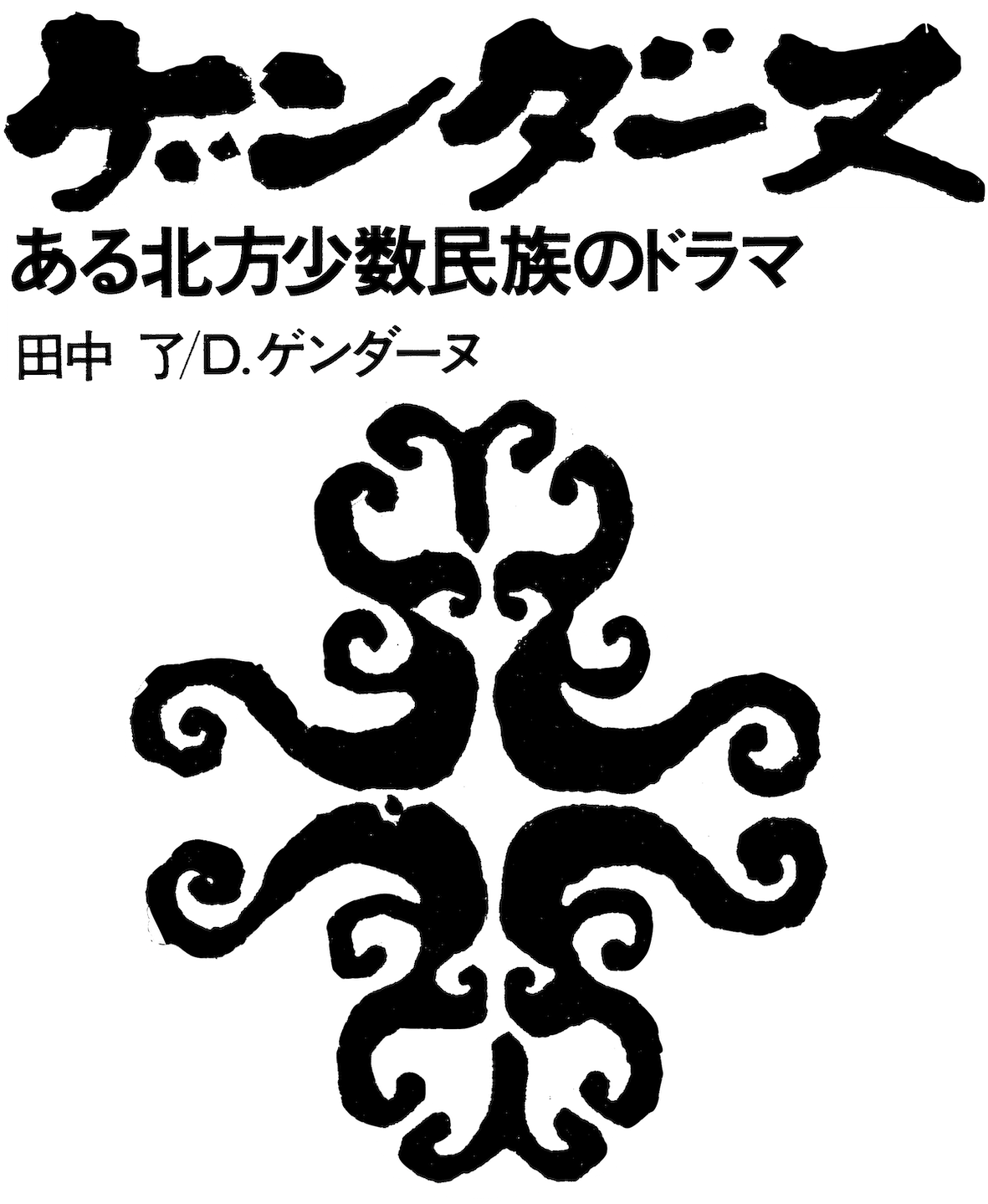 「ダーヒン
ニェニ・ゲンダーヌ(日本名:北川源太郎、ウィルタ語名:Dahinien Gendanu / Daxinnieni Geldanu,
1926年頃 - 1984年7月8日)は、樺太生まれのウィルタ(オロッコ, Oroks)
民族研究家・運動家である。ウィルタ民族。第二次世界大戦中は特務機関員として日本軍に協力した。終戦後はシベリアにて抑留され、帰国後は北海道網走市に
移住して肉体労働で生計をつないだ。自民族の研究家として活動し、戦後ウィルタ運動のリーダーとして北方少数民族の復権運動に尽力した。その後彼の呼びか
けにより網走に作られたウィルタ文化資料館「ジャッカ・ドフニ」の初代館長となった。ダーヒンニェニ・ゲンダーヌという名前は「北の川のほとりに住む者」
を意味する。ウィルタの呪者の家系に生まれ長老であった義父北川ゴルゴロと同様に遊牧と狩猟で生活を営んでいた。1942年(昭和17年)日本陸軍の特務
機関は戸籍が未整備だった樺太の少数民族の若者へも召集をかけ、ソ連軍の動きを探るための諜報活動や軍事訓練へと当たらせた。当時敷香町在住のオロッコ族
22人ギリヤーク族(ニヴヒ)18人の計40人もまた日本名を付けられ諜報部隊に所属した。彼ら「北方戦線の秘密戦士」の中の一人がゲンダーヌであった。
ソ連の参戦後、10年近くシベリアに抑留され、敷香特務機関配下60人のうち59人が強制労働にて死亡。ゲンダーヌ一人だけが生き残った。その後ソ連の占
領下の樺太へ帰島することも叶わず父とともに北海道網走へ移住したが、日本国籍は与えられず、ウィルタであることを隠して差別から逃れた(後に就籍)。肉
体労働で生計を繋ぎつつ、少数民族の軍人恩給支給問題を国へ訴えた。1976年、この問題は国会において議論されたが、当時の少数民族に日本国籍はなく兵
役義務もなく非公式の令状にて召集されたとして、彼らに戦後補償が与えられることはなかった。しかしながら彼の告発をきっかけに、1975年に「オロッコ
の人権と文化を守る会」(翌年ウィルタ協会と改称)が発足。資料館の建設、慰霊碑の建設、樺太の同胞との交流という3つの願いを彼は抱いた[1][2]。
北方少数民族の文化を残したいという彼の呼びかけにより780万円の募金が集まり、1978年に網走市が提供した土地にウィルタ語で「大切な物を収める
家」という意味のジャッカ・ドフニと名付けられた資料館が完成し、その館長となった。資料館にはウィルタの他ニブヒ、樺太アイヌなどの民族の宗教・生活用
具、衣装など約600点の資料を収蔵・展示し、踊りの実演なども行われる。また、1982年5月には網走市天都山に合同慰霊碑「キリシエ」が建立された。
1984年に急逝。その後、建物老朽化などを理由にウィルタ協会はジャッカ・ドフニの閉館を決定し、2010年に32年の歴史を閉じた[1]。閉館後、収
蔵資料は北海道立北方民族博物館に移管されている[1]。」
「ダーヒン
ニェニ・ゲンダーヌ(日本名:北川源太郎、ウィルタ語名:Dahinien Gendanu / Daxinnieni Geldanu,
1926年頃 - 1984年7月8日)は、樺太生まれのウィルタ(オロッコ, Oroks)
民族研究家・運動家である。ウィルタ民族。第二次世界大戦中は特務機関員として日本軍に協力した。終戦後はシベリアにて抑留され、帰国後は北海道網走市に
移住して肉体労働で生計をつないだ。自民族の研究家として活動し、戦後ウィルタ運動のリーダーとして北方少数民族の復権運動に尽力した。その後彼の呼びか
けにより網走に作られたウィルタ文化資料館「ジャッカ・ドフニ」の初代館長となった。ダーヒンニェニ・ゲンダーヌという名前は「北の川のほとりに住む者」
を意味する。ウィルタの呪者の家系に生まれ長老であった義父北川ゴルゴロと同様に遊牧と狩猟で生活を営んでいた。1942年(昭和17年)日本陸軍の特務
機関は戸籍が未整備だった樺太の少数民族の若者へも召集をかけ、ソ連軍の動きを探るための諜報活動や軍事訓練へと当たらせた。当時敷香町在住のオロッコ族
22人ギリヤーク族(ニヴヒ)18人の計40人もまた日本名を付けられ諜報部隊に所属した。彼ら「北方戦線の秘密戦士」の中の一人がゲンダーヌであった。
ソ連の参戦後、10年近くシベリアに抑留され、敷香特務機関配下60人のうち59人が強制労働にて死亡。ゲンダーヌ一人だけが生き残った。その後ソ連の占
領下の樺太へ帰島することも叶わず父とともに北海道網走へ移住したが、日本国籍は与えられず、ウィルタであることを隠して差別から逃れた(後に就籍)。肉
体労働で生計を繋ぎつつ、少数民族の軍人恩給支給問題を国へ訴えた。1976年、この問題は国会において議論されたが、当時の少数民族に日本国籍はなく兵
役義務もなく非公式の令状にて召集されたとして、彼らに戦後補償が与えられることはなかった。しかしながら彼の告発をきっかけに、1975年に「オロッコ
の人権と文化を守る会」(翌年ウィルタ協会と改称)が発足。資料館の建設、慰霊碑の建設、樺太の同胞との交流という3つの願いを彼は抱いた[1][2]。
北方少数民族の文化を残したいという彼の呼びかけにより780万円の募金が集まり、1978年に網走市が提供した土地にウィルタ語で「大切な物を収める
家」という意味のジャッカ・ドフニと名付けられた資料館が完成し、その館長となった。資料館にはウィルタの他ニブヒ、樺太アイヌなどの民族の宗教・生活用
具、衣装など約600点の資料を収蔵・展示し、踊りの実演なども行われる。また、1982年5月には網走市天都山に合同慰霊碑「キリシエ」が建立された。
1984年に急逝。その後、建物老朽化などを理由にウィルタ協会はジャッカ・ドフニの閉館を決定し、2010年に32年の歴史を閉じた[1]。閉館後、収
蔵資料は北海道立北方民族博物館に移管されている[1]。」
リンク
文献
その他の情報
Copyleft, CC, Mitzub'ixi Quq Chi'j, 1996-2099

Copyleft,
CC, Mitzub'ixi Quq Chi'j, 1996-2099